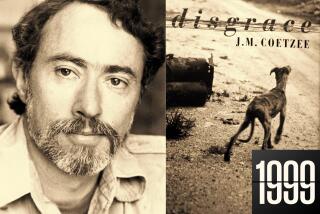âKoestlerâ by Michael Scammell
Koestler
The Literary and Political Odyssey
of a Twentieth-Century Skeptic
Michael Scammell
Random House: 694 pp., $35
It is clear in Michael Scammellâs comprehensive biography that Arthur Koestler was an exceedingly difficult and troubled man. Even those who revered Koestler as the author of âDarkness at Noon,â his devastating masterpiece tracing communismâs degeneration from revolutionary dream to totalitarian nightmare, were often appalled by his personal excesses and disturbed by his take-no-prisoners style of political debate. His later writings on science, challenging Darwinism and defending parapsychology, led many to dismiss him as a crackpot. When he committed suicide due to failing health in 1983 and his much younger wife chose to die with him, it provided a scandalous finale to a life packed with controversy.
Scammell, a noted translator of Russian literature and author of a prize-winning biography of Alexander Solzhenitsyn, graphically renders Koestlerâs fiery personality and the turbulent decades in which he prowled the world stage. A more selective account would have brought Koestlerâs most important achievements into sharper relief, but this lengthy book certainly captures the epic sweep of his experiences and the ferocity of his convictions.
Koestler was born into an affluent Jewish family in Budapest in 1905, and before he turned 30 had been an engineering student in Vienna, a militant Zionist in Palestine and a celebrated science journalist in Berlin. Weimar Germany was a stimulating place for an ambitious, multilingual cosmopolitan who liked to drink hard, sleep around and argue all night about politics, religion and art, but Koestler was restless and unsatisfied. Marxism appealed to what Scammell cogently terms his âtaste for black-and-white political solutions,â and he joined the German Communist Party in January 1932.
Koestlerâs six years in the party plunged him into a world of revolutionary faith increasingly contradicted by facts that would give him his subject matter and his voice as a writer after he was arrested while reporting on the Spanish Civil War in 1937. âEvery line he wrote after Spain,â Scammell observes in the bookâs best chapter, âwas different in quality and spirit.â While he was in jail, he heard fellow prisoners dragged out to be executed and wondered whether he would be next; desperately grateful when granted small favors like a shave or a cigarette, he âfirst glimpsed the complex chemistry of masters and slaves that smoothed the way for Stalinâs show trials.â He had ample time to reflect on the lies and evasions he had perpetrated as part of the partyâs propaganda machine, reflections that infused the intimate portrait of his Old Bolshevik protagonist in âDarkness at Noon.â
Written during the chaotic early months of World War II, as Koestler scrambled desperately to get out of Europe, the novel was published in England in December 1940, just a month after he landed in Bristol, a penniless refugee who was promptly jailed as politically suspect and personally unstable. A year later, âDarkness at Noonâ was a bestseller in the U.S. Finally published in liberated France, it sold 300,000 copies and was credited as a factor in the Communist Partyâs 1946 electoral defeat there.
Koestler wrote a few more novels, including the controversial âThieves in the Night,â which tacitly supported Jewish terrorism in then-British-ruled Palestine, and several volumes of memoirs that powerfully portrayed individual lives swept up in the course of history. But his greatest prominence in the postwar decade was as a vocal, divisive anti-communist activist. Though Ignazio Silone and other ex-communists struggled to find a socialist âthird wayâ between American capitalism and Soviet totalitarianism, Koestler uncompromisingly sided with the U.S. and asserted that there was no middle ground. Scammell generally concurs with Koestlerâs dismissive view of his adversaries on the anti-communist left, though he acknowledges that the writer had little understanding of how fear of the Soviets was being used by right-wing forces in America.
Striving to do justice to his thorny subjectâs multifarious public concerns and eclectic literary output in the second half of his life, Scammell has trouble maintaining narrative focus. Itâs understandable, since Koestler roamed the globe, even after making England his permanent home in 1952, and spoke out on everything, including capital punishment and psychedelic drugs as a path to enlightenment (he was against both). But Scammellâs conscientious enumeration of events, places and people never really comes to grips with a central trait Koestler himself named: a âthirst for the absoluteâ that was never slaked.
This thirst can be discerned in his later books: the nostalgia he expressed for a golden age of science âwhen faith and reason were one,â his distaste for Darwinism with its random mutations, his interest in parapsychology as a glimpse into the âfundamental unity of all things.â Few knew better than Koestler the horrors that resulted from imposing absolute doctrines on human complexities, yet he would never cease yearning for certainty. Scammellâs subtitle is misleading: A âskepticâ is just about the last thing Koestler was.
Point to point, this biography is intelligent and perceptive, but too often the essential is swamped by the extraneous. Scammell is astute, for example, about the particulars of Koestlerâs stormy marriages and love affairs; the relationship with third wife Cynthia, who killed herself with him, is worthy of a Russian novel. But he covers them in excessive detail, and on occasion his desire to convey their ambiguities crosses into making excuses for Koestlerâs repulsive behavior. Similarly, although Scammell spotlights some valid ideas in Koestlerâs science books, particularly the insights into the creative nature of scientific discovery, he too often (and not always persuasively) tries to buttress their respectability by suggesting that they presciently anticipated future developments. This skirts the main issue: These books wielded neither the authority nor the influence of Koestlerâs autobiographical and political writings in the 1940s and 1950s.
His most enduring achievement stands alone: his single great novel, his truest self-portrait. âDarkness at Noon,â with its searing depiction of idealistic ends soiled by brutal means, of personal conscience betrayed in service to a vision of social justice and universal brotherhood whose allure remains agonizingly apparent, is a distinctively 20th century tragedy with eternal resonance. It tells us more about Arthur Koestler than any biography ever could.
Smith is the author of âReal Life Drama: The Group Theatre and America, 1931-1940.â
More to Read
Sign up for our Book Club newsletter
Get the latest news, events and more from the Los Angeles Times Book Club, and help us get L.A. reading and talking.
You may occasionally receive promotional content from the Los Angeles Times.








